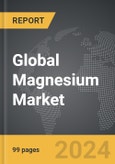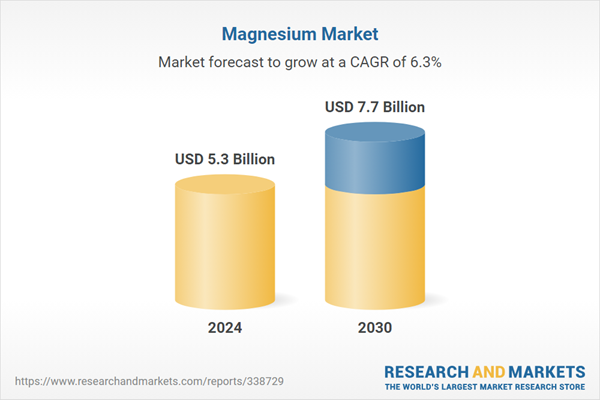Magnesium - Key Trends and Drivers
Magnesium is a lightweight, silvery-white metal, recognized as the eighth most abundant element in the earth's crust and the third most plentiful element dissolved in seawater. This element is well-known for its low density and high strength-to-weight ratio, making it an ideal choice for applications where weight reduction is critical. Magnesium alloys are extensively used in the automotive and aerospace industries to improve fuel efficiency by reducing vehicle weight. Additionally, magnesium is crucial in the production of aluminum alloys and is also used in the manufacture of electronics, such as mobile phones and laptops, due to its excellent heat dissipation properties. One of the primary growth drivers for magnesium is the automotive industry's ongoing push towards lighter vehicles. As global regulations on carbon emissions become stricter, automakers are increasingly turning to lightweight materials like magnesium alloys, which can significantly reduce a vehicle's weight and thus its fuel consumption and emissions. This trend is bolstered by technological advancements in magnesium alloy production, which are making these materials more cost-effective and robust, further enhancing their appeal to industries focused on energy efficiency and environmental sustainability.Aircraft manufacturers are continuously seeking ways to enhance the fuel efficiency of their fleets, driven by both economic factors and environmental regulations. Magnesium's use in aircraft construction, particularly in components such as seats, gearboxes, and engine parts, is expanding because it offers a substantial weight reduction compared to traditional materials. Moreover, the growth of the global aerospace sector, spurred by increasing air travel and military expenditures, is expected to further drive the demand for magnesium.
Emerging trends in the magnesium market include the development of new magnesium-based materials for medical applications, such as biodegradable implants that naturally dissolve in the body without leaving any residue. Additionally, the drive towards sustainable and recyclable materials is enhancing the appeal of magnesium in various industries. As magnesium recycling technologies improve, the environmental impact of magnesium production is expected to decrease, aligning with global sustainability goals and potentially lowering production costs. These factors combined suggest a promising growth trajectory for magnesium, supported by its expanding application range and the global shift towards lightweight, durable, and eco-friendly materials.
Report Scope
The report analyzes the Magnesium market, presented in terms of market value (US$ Thousand). The analysis covers the key segments and geographic regions outlined below.- Segments: Application (Aluminum Alloying, Die Casting, Metal Reduction, Desulfurization, Other Applications).
- Geographic Regions/Countries:World; United States; Canada; Japan; China; Europe (France; Germany; Italy; United Kingdom; Spain; Russia; and Rest of Europe); Asia-Pacific (Australia; India; South Korea; and Rest of Asia-Pacific); Latin America (Argentina; Brazil; Mexico; and Rest of Latin America); Middle East (Iran; Israel; Saudi Arabia; United Arab Emirates; and Rest of Middle East); and Africa.
Key Insights:
- Market Growth: Understand the significant growth trajectory of the Aluminum Alloying Application segment, which is expected to reach US$2.7 Billion by 2030 with a CAGR of a 6.5%. The Die Casting Application segment is also set to grow at 7% CAGR over the analysis period.
- Regional Analysis: Gain insights into the U.S. market, valued at $1.4 Billion in 2024, and China, forecasted to grow at an impressive 9.6% CAGR to reach $1.8 Billion by 2030. Discover growth trends in other key regions, including Japan, Canada, Germany, and the Asia-Pacific.
Why You Should Buy This Report:
- Detailed Market Analysis: Access a thorough analysis of the Global Magnesium Market, covering all major geographic regions and market segments.
- Competitive Insights: Get an overview of the competitive landscape, including the market presence of major players across different geographies.
- Future Trends and Drivers: Understand the key trends and drivers shaping the future of the Global Magnesium Market.
- Actionable Insights: Benefit from actionable insights that can help you identify new revenue opportunities and make strategic business decisions.
Key Questions Answered:
- How is the Global Magnesium Market expected to evolve by 2030?
- What are the main drivers and restraints affecting the market?
- Which market segments will grow the most over the forecast period?
- How will market shares for different regions and segments change by 2030?
- Who are the leading players in the market, and what are their prospects?
Report Features:
- Comprehensive Market Data: Independent analysis of annual sales and market forecasts in US$ Million from 2024 to 2030.
- In-Depth Regional Analysis: Detailed insights into key markets, including the U.S., China, Japan, Canada, Europe, Asia-Pacific, Latin America, Middle East, and Africa.
- Company Profiles: Coverage of players such as Albemarle Corporation, Aremco Products, Inc., Belmont Metals, Inc., Companhia Siderurgica Nacional SA (CSN), Dead sea Magnesium Ltd. and more.
- Complimentary Updates: Receive free report updates for one year to keep you informed of the latest market developments.
Some of the 73 companies featured in this Magnesium market report include:
- Albemarle Corporation
- Aremco Products, Inc.
- Belmont Metals, Inc.
- Companhia Siderurgica Nacional SA (CSN)
- Dead sea Magnesium Ltd.
- Israel Chemicals Ltd. (ICL)
- Lehmann & Voss & Co. KG
- POSCO
- PQ Corporation
- Tokuyama Corporation
This edition integrates the latest global trade and economic shifts into comprehensive market analysis. Key updates include:
- Tariff and Trade Impact: Insights into global tariff negotiations across 180+ countries, with analysis of supply chain turbulence, sourcing disruptions, and geographic realignment. Special focus on 2025 as a pivotal year for trade tensions, including updated perspectives on the Trump-era tariffs.
- Adjusted Forecasts and Analytics: Revised global and regional market forecasts through 2030, incorporating tariff effects, economic uncertainty, and structural changes in globalization. Includes historical analysis from 2015 to 2023.
- Strategic Market Dynamics: Evaluation of revised market prospects, regional outlooks, and key economic indicators such as population and urbanization trends.
- Innovation & Technology Trends: Latest developments in product and process innovation, emerging technologies, and key industry drivers shaping the competitive landscape.
- Competitive Intelligence: Updated global market share estimates for 2025, competitive positioning of major players (Strong/Active/Niche/Trivial), and refined focus on leading global brands and core players.
- Expert Insight & Commentary: Strategic analysis from economists, trade experts, and domain specialists to contextualize market shifts and identify emerging opportunities.
Table of Contents
Companies Mentioned (Partial List)
A selection of companies mentioned in this report includes, but is not limited to:
- Albemarle Corporation
- Aremco Products, Inc.
- Belmont Metals, Inc.
- Companhia Siderurgica Nacional SA (CSN)
- Dead sea Magnesium Ltd.
- Israel Chemicals Ltd. (ICL)
- Lehmann & Voss & Co. KG
- POSCO
- PQ Corporation
- Tokuyama Corporation
Table Information
| Report Attribute | Details |
|---|---|
| No. of Pages | 220 |
| Published | December 2025 |
| Forecast Period | 2024 - 2030 |
| Estimated Market Value ( USD | $ 5.3 Billion |
| Forecasted Market Value ( USD | $ 7.7 Billion |
| Compound Annual Growth Rate | 6.3% |
| Regions Covered | Global |









